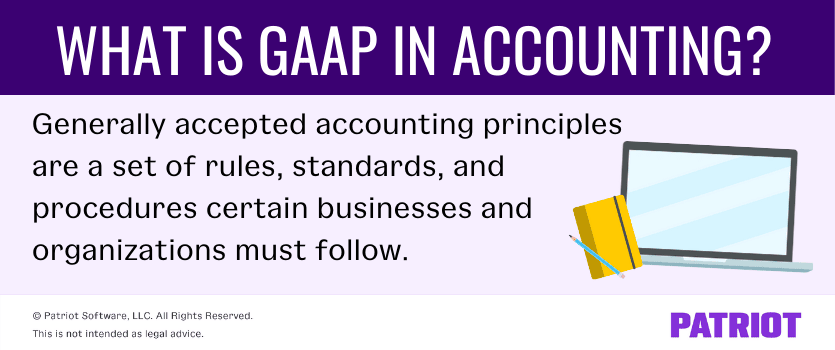When it comes to accounting, you must follow certain rules for recordkeeping or tax reporting. Otherwise, you may wind up making mistakes and costing your company money—and nobody wants that. Many businesses must follow a set of accounting guidelines called GAAP. But, what is GAAP exactly? And, how do you know if you have to follow said guidelines? Let us give you the GAAP rules rundown.
What is GAAP?
What does GAAP stand for? GAAP stands for generally accepted accounting principles. Generally accepted accounting principles are a set of rules, standards, and procedures certain businesses and organizations must follow.
GAAP in accounting helps businesses:
- Organize financial information into accounting records
- Summarize accounting records into financial statements
- Disclose certain supporting financial information
Generally accepted accounting principles ensure businesses use a standard method to report financial information. Think of these principles as a rulebook that companies follow when creating financial statements (e.g., income statement, balance sheet, and cash flow statement).
Under GAAP, you need to structure your financial statements the same way from year to year. And, financial statement outlines should be the same as other businesses following GAAP.
These accounting principles determine how to create financial statements. The standard format makes it easy for investors, lenders, and auditors to gather information about your business.
With GAAP, you must also use accrual accounting. Accrual accounting is the most complex method that uses more advanced accounts, such as accounts payable and long-term liabilities.
What principles does the GAAP include?
GAAP includes a wide range of topics, including financial statement presentation, assets, liabilities, equity, revenue, expenses, fair value, nonmonetary transactions, and so on.
The GAAP has 10 principles—the Principle of:
- Regularity: Businesses must follow all specific rules and regulations.
- Consistency: Consistently apply the same accounting standards to your entire accounting process.
- Sincerity: Provide an accurate and impartial depiction of your business’s financial situation.
- Permanence of Methods: The procedures you use in financial reporting should be consistent, making it easy to compare financial information.
- Non-compensation: Businesses must report positives and negatives and be completely transparent about their finances. Report both assets and liabilities separately.
- Prudence: Be prudent, or conservative, when deciding which accounting methods to use.
- Continuity: Conduct accounting based on the assumption that your business will continue to operate.
- Periodicity: Report financial information at regular intervals.
- Materiality: Fully disclose all financial data and accounting information in financial reports.
- Utmost Good Faith: Honestly record transactions and collect financial data.
In addition to the above, you must also follow these four principles while creating financial statements:
- Recognition: Your financial statements should accurately show all of your company’s assets, liabilities, revenue, and expenses.
- Measurement: Financial statements should measure and show financial results in accordance with GAAP standards.
- Presentation: For financial statements, you should include an income statement, a balance sheet, a cash flow statement, and a statement of shareholder’s equity.
- Disclosure: Financial statements should include any necessary notes to fully explain the financial information you provide.

Who sets GAAP?
The Financial Accounting Standards Board (FASB) and the Securities and Exchange Commission (SEC) set GAAP.
The SEC has the ability under securities law to both set and enforce accounting standards, while the FASB can only set accounting standards.
The Governmental Accounting Standards Board (GASB) also establishes GAAP accounting standards, but these are for state and local governments.
Both the FASB and the GASB are overseen by the Financial Accounting Foundation (FAF). Although the FASB and GASB both establish GAAP accounting principles, businesses follow the set of guidelines created by the FASB.
Who must follow GAAP guidelines?
Not all businesses need to follow GAAP guidelines. You must follow the generally accepted accounting principles if you are a:
- Publicly traded business (required by SEC)
Publicly traded companies are required to use GAAP. That way, they all measure and report financial information in the same way for others (e.g., investors).
Private companies and GAAP
Does GAAP apply to private companies? Private companies are not required to follow GAAP because they generally keep financial information for tax purposes only. However, it doesn’t hurt to follow the accounting principles if you’re a private company and plan on providing financial statements to people outside of your business.
Even if you’re not required to, you may want to use GAAP to better communicate with other business owners, accountants, investors, and lenders. You can also use GAAP reporting to help compare your business’s financial statements to others in your industry to see where you fall.
Thinking about following GAAP for private companies? You may want to use GAAP if you:
- Plan on growing or expanding
- Need another way to spot inconsistencies and fraud
- Want to gain a clearer understanding of your business’s financial health
- Are looking to improve and streamline your finances
- Need to gauge your pricing
Keep in mind that switching from non-GAAP to GAAP can be a little challenging. If you plan on growing or want to better track your finances, try using GAAP from the get-go.
This article has been updated from its original publication date of October 27, 2015.
This is not intended as legal advice; for more information, please click here.




